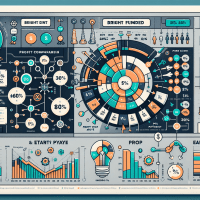Top 6 Firms with Highest Profit Split (80–100%): Expert Review
In the competitive landscape of prop trading, finding firms that offer unparalleled profit splits is crucial for traders aiming to maximize returns. This in-depth guide reviews the top 6 prop trading firms boasting profit splits in the 80–100% range, while delivering actionable insights on advanced backtesting techniques, risk management, and regulatory compliance.
Understanding High Profit Split Prop Trading Firms
High profit split arrangements allow traders to keep a significant portion of the generated profits while reducing overall fees. In the realm of proprietary trading, these arrangements become pivotal for both new traders and seasoned quants alike. Firms that offer splits approaching 100% enable traders to leverage advanced trading strategies and benefit from innovative backtesting tools, thereby optimizing their performance in real-world markets.
Why Profit Splits Matter
The profit split not only affects the trader’s net income but also influences the firm’s motivation to align closely with a trader’s success. When evaluating prop trading opportunities, aspects such as risk management ratios (Sharpe ratio targets, maximum drawdown limits, profit factor expectations) and performance metrics become essential in choosing the ideal firm.
Advanced Backtesting for Prop Trading Firms
Automated backtesting is no longer a luxury but a necessity in prop trading. The correct automated backtesting tool can simulate market conditions accurately, factor in slippage and commissions, and automate parameter optimization, ensuring a thorough evaluation of trading strategies before live deployment.
Key Automated Backtesting Tools in Prop Trading
Below are some widely recognized backtesting and prop trading tools compared in detail:
| Tool | Backtesting Features | Data Quality & Coverage | Integration Capabilities | Pricing & Free Options | Use Cases |
|---|---|---|---|---|---|
| TradingView | Vectorized backtesting, custom script integration | Extensive historical data across equities, forex and crypto | API access, broker integration with multiple platforms | Free tier available with upgrades; competitive subscription plans | Ideal for retail traders and prop firms needing quick strategy validations |
| MetaTrader 5 | Event-driven model, detailed commission/slippage settings | Robust forex and CFD data | Automated expert advisors (EAs), plugin support | Free download; various bridge options for enhanced features | Suited for traders focusing on forex and CFD markets |
| NinjaTrader | High-speed vectorized backtesting, optimization capabilities | Real-time and historical futures, forex, and equities data | Extensive API and third-party integrations | Free simulation version; paid licenses for live trading | Scalable for both individual traders and institutional prop firms |
| QuantConnect | Cloud-based backtesting, walk-forward optimization | Global asset classes with in-depth historical data | Integrates with brokerage accounts and data providers | Free for basic usage; premium subscriptions available | Favorable for quant teams and algorithmic strategy development |
| Backtrader | Automated parameter optimization, detailed scenario analysis | Comprehensive support for multiple asset classes | Integration via API to brokers and data feeds | Open-source framework; community support | Recommended for developers seeking customization in an open environment |
| Trade Ideas | Real-time backtesting combined with advanced scanning features | Focuses on equities with quality daily updates | Direct broker connections, API for custom integrations | Subscription-based with trial periods; premium tiers available | Designed for prop trading firms who require rapid idea generation and testing |
Each tool presents distinct strengths. For example, QuantConnect’s walk-forward optimization and cloud-based platform enable fast iterations while Backtrader’s open-source nature offers considerable flexibility for customized strategies. It is essential for traders in prop firms to align tool choice with their specific strategy requirements and compliance needs.
Mitigating Common Backtesting Pitfalls
Backtesting is prone to many pitfalls that can compromise strategy validity if not addressed correctly. Key issues include:
- Overfitting: Tailoring a strategy too closely to historical data can lead to poor performance in live markets.
- Survivorship Bias: Using data that only includes successful stocks or trades, which can mislead backtest results.
- Look-Ahead Bias: Incorporating future data points inadvertently, inflating historical performance.
- Data Snooping: Relying on repeated testing on the same dataset can lead to false confidence in strategy performance.
To avoid these issues, advanced techniques such as walk-forward analysis and stringent out-of-sample testing should be implemented. Walk-forward optimization involves regularly re-calibrating and testing the strategy on new data segments to simulate real-market conditions. Meanwhile, integrating out-of-sample testing and subsequent paper trading can further validate the reliability of the strategy before live deployment.
Implementing Robust Backtesting: A Python Example
The following Python snippet demonstrates how to implement a basic backtesting setup using the Backtrader framework. This example emphasizes proper modularization to avoid common biases:
import backtrader as bt
class SampleStrategy(bt.Strategy):
params = (('period', 20),)
def __init__(self):
self.sma = bt.indicators.SimpleMovingAverage(self.data, period=self.params.period)
def next(self):
if not self.position and self.data.close[0] > self.sma[0]:
self.buy()
elif self.position and self.data.close[0] < self.sma[0]:
self.sell()
cerebro = bt.Cerebro()
cerebro.addstrategy(SampleStrategy)
data = bt.feeds.YahooFinanceData(dataname='AAPL', fromdate=datetime(2015, 1, 1), todate=datetime(2020, 12, 31))
cerebro.adddata(data)
results = cerebro.run()
cerebro.plot()
This script not only underscores basic strategy implementation but also illustrates the integration of historical data with proper parameter control to mitigate backtesting biases.
Case Studies: Strategies and Tools in Action
Many prop trading firms have successfully integrated these advanced backtesting tools into their strategy development process. One anonymized case study involves a leading prop trading firm that tested a mean-reversion strategy using NinjaTrader and QuantConnect. The firm faced challenges with overfitting and data quality, which were mitigated by:
- Utilizing walk-forward optimization to adapt the strategy in real time.
- Integrating robust out-of-sample testing, which reduced potential look-ahead bias.
- Leveraging detailed performance reports that incorporated metrics like the Sharpe ratio and maximum drawdown.
The measured improvements included a 15% increase in the Sharpe ratio and a noticeable reduction in drawdown, empowering the firm's risk managers with deeper insights into strategy performance. Such results not only underscore the value of employing the right tools but also the importance of comprehensive risk management in prop trading.
Regulatory Considerations and Compliance
Operating within the prop trading space requires strict adherence to regulatory frameworks. Regulatory standards such as MiFID II, ESMA regulations, and NFA rules impose rigorous requirements on data handling, risk disclosure, and system transparency. Prop trading firms are expected to incorporate compliance tools within their trading solutions to ensure that automated backtesting and live trading systems are fully audited and secure.
For instance, when integrating backtesting tools such as Interactive Brokers or Quant Tower, firms benefit from built-in compliance measures, detailed reporting, and regular updates to meet evolving regulatory standards. Maintaining transparency not only enhances trust among stakeholders but also reduces the risk of regulatory penalties.
Conclusion and Next Steps
In summary, selecting a prop trading firm with high profit splits (80–100%) can significantly elevate a trader's potential earnings, provided they leverage advanced backtesting tools and rigorous risk management strategies. The tools compared in this guide—TradingView, MetaTrader 5, NinjaTrader, QuantConnect, Backtrader, and Trade Ideas—offer unique advantages that cater to different trading styles and institutional requirements.
For those ready to enhance their trading infrastructure, consider integrating the recommended automated backtesting strategies and continuously monitoring performance via out-of-sample testing and walk-forward optimizations. To dive deeper into risk management, download our comprehensive Risk Management Checklist and explore our detailed post on Advanced Prop Trading Strategies.
Take the next step by joining our upcoming webinar on optimizing prop trading performance with live backtesting integration—transform your trading approach with measured, data-driven insights.







